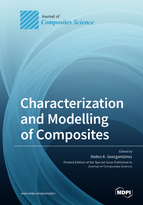Characterization and Modelling of Composites
A special issue of Journal of Composites Science (ISSN 2504-477X). This special issue belongs to the section "Composites Modelling and Characterization".
Deadline for manuscript submissions: closed (30 November 2020) | Viewed by 38947
Special Issue Editor
Interests: nanostructures; nanocomposites; composite structures; finite element method; design; modeling; computational analysis; nanotechnology
Special Issues, Collections and Topics in MDPI journals
Special Issue Information
Dear Colleagues,
Composites have been increasingly used in various structural components in the aerospace, marine, automotive, and wind energy sectors. Composites’ material characterization is a vital part of the product development and production process. Physical, mechanical, and chemical characterization helps developers to further their understanding of products and materials, thus ensuring quality control. Achieving an in-depth understanding and consequent improvement of the general performance of these materials, however, still requires complex material modeling and simulation tools, which are often multiscale and encompass multiphysics.
This Special Issue is aimed at soliciting promising, recent developments in composite modeling, simulation, and characterization, in both design and manufacturing areas, including experimental as well as industrial-scale case studies. All submitted manuscripts will undergo a rigorous review and will only be considered for publication if they meet journal standards. Selected top articles may have the processing charges waived at the recommendation of reviewers and the Guest Editor.
Prof. Stelios K. Georgantzinos
Guest Editor
Manuscript Submission Information
Manuscripts should be submitted online at www.mdpi.com by registering and logging in to this website. Once you are registered, click here to go to the submission form. Manuscripts can be submitted until the deadline. All submissions that pass pre-check are peer-reviewed. Accepted papers will be published continuously in the journal (as soon as accepted) and will be listed together on the special issue website. Research articles, review articles as well as short communications are invited. For planned papers, a title and short abstract (about 100 words) can be sent to the Editorial Office for announcement on this website.
Submitted manuscripts should not have been published previously, nor be under consideration for publication elsewhere (except conference proceedings papers). All manuscripts are thoroughly refereed through a single-blind peer-review process. A guide for authors and other relevant information for submission of manuscripts is available on the Instructions for Authors page. Journal of Composites Science is an international peer-reviewed open access monthly journal published by MDPI.
Please visit the Instructions for Authors page before submitting a manuscript. The Article Processing Charge (APC) for publication in this open access journal is 1800 CHF (Swiss Francs). Submitted papers should be well formatted and use good English. Authors may use MDPI's English editing service prior to publication or during author revisions.
Keywords
- Fiber-reinforced composites
- Unidirectional and woven reinforcements
- Noncrimp fabrics (NCFs)
- Three-dimensional composites
- Nanocomposites
- Natural fiber and biocomposites
- Hybrid composites
- Composite structures
- Modeling and characterization
- Numerical simulation
- Experimental studies
- Industrial case studies






